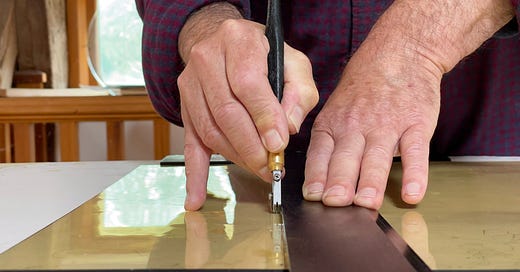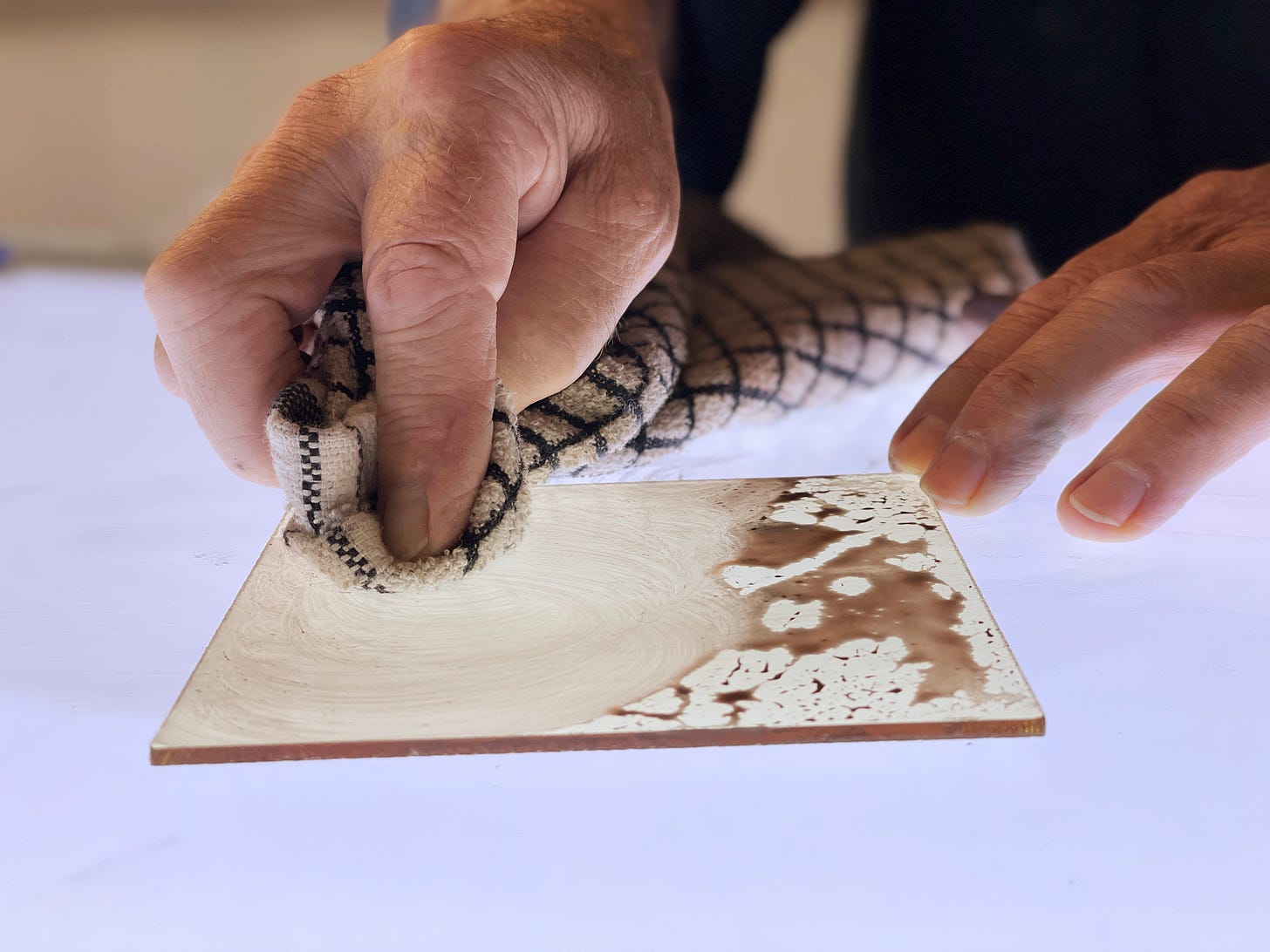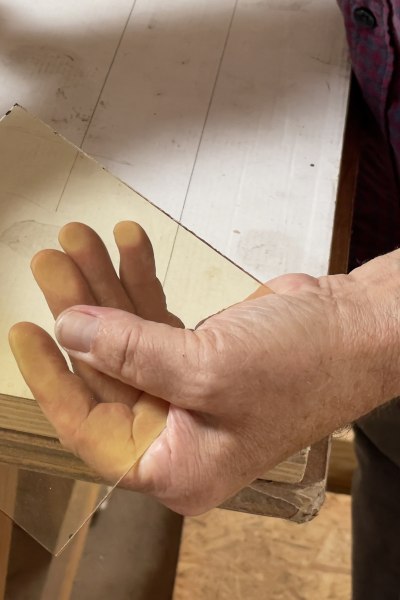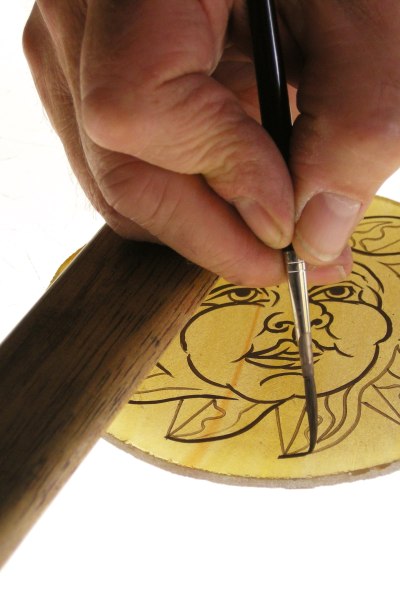This particular letter — the first in a series devoted to techniques — I address to those of you who are new to stained glass painting, as well as to my daughter, a teenaged innocent, stubbornly avoiding the delights on her own doorstep in favour of distant pleasures: such is the time-honoured, contrarian spirit of this child-no-longer, she declined to spend time in the studio and left home instead …
Anyone would think that glass painting was old-fashioned or that I might be difficult to work with.
Imagining, however, that we all want to start painting, there are three tasks to accomplish before we can:
Obtain the right brushes, tools and paint. It will save you vast quantities of time if you follow our recommendations summarised here and published here.
Mix your glass paint. This wouldn’t be difficult except for false hopes. It is therefore important that you reconcile yourself to at least 30 minutes’ careful labour the first time you do it: then all of life is sweet again. Here’s a short course on how we mix our paint.
Whilst your paint is resting, you can cut and prepare your glass.
Complete these three tasks, and everything will be ready for you to practise without distraction.
The third task’s lack of hyperlink will lead you to conclude that this is a topic we must address: here, therefore, for newcomers and my wilful teenager, are our proposals for choosing, cutting and preparing glass when someone first begins to learn.
At the very end of this letter, so that everyone (not just beginners) gets something, you’ll find a free guide to how you might paint a stained glass sun like this one here:
Now to the third and last of those preparatory tasks.
Buy your glass, which should be 2 or 3 mm thick, and smooth.
Avoid dark colours to start with: dark colours are challenging to trace on because you cannot easily see the design beneath the glass which you are copying. Also, dark colours make it difficult to judge the quality of your painting.
Float glass is acceptable, but a light yellow, light green or light pink is far more pleasant: on your light box, this tinted glass will give your eyes a welcome hint of warmth, yet the colour is still gentle enough that you can easily assess how wet or dry your paint is, which is essential to monitoring and improving your performance.
This clip is considerably sped up but you’ll still see how that this light pink is pleasant on the eye:
To anticipate:
The patch of paint on the light box is the “test patch”. It’s where you test how dark or light or dry or runny your paint is. It’s an early-warning system.
The half-piece of glass is what you use to make sure you’ve picked the right brush, that you remember how and where to hold it, that the paint is as it should be, and generally to rehearse the kind of lines and curves you will be painting.
The larger piece of glass is where you paint as superbly as you can, now that you’ve used the test patch and the half-piece to test and warm up.
That’s how we mostly work, at any rate. And there’ll be plenty of occasions when you can watch us painting at our normal pace.
As for how we teach, first we show you what we do, and then we suggest you copy us maybe three times, but it could be five or ten times or more, just as a musician might learn to play a piece of music by repeating it again and again, paying special attention to those sections he finds difficult.
I make this point because newcomers, especially those who don’t play a musical instrument, sometimes imagine you might learn skill from a design the same way you squeeze a lemon: do it once, and all the juice is extracted.
Far from it. I shamelessly repeat a design the same way I repeat a prelude. My daughter once complained I had been playing the same piano scale for more than an hour. She was right: A-flat melodic minor in contrary motion — it’s my favourite. Not wishing to be unreasonable around the home, I duly changed to the harmonic minor. Nor did I treat this scale as if it were a lemon.
To the end of repetitive and distraction-free practise, we’ve prepared many of our exercises and designs so you can paint them on just one size of glass.
This size is 120 by 120 mm, about 4 and 3/4 inches square: the size in the above video.
A little larger is fine, but smaller is not because cramped spaces are more difficult to work in.
This standard size means you can cut yourself lots of identical pieces of glass and have them ready for you to practise on:
You can then repeat the same exercise again and again, take a break, look at the different pieces, and consider which of them went well and why, and which of them went badly and why.
You might decide to keep one or two pieces as mementos, a diary entry if you will to look back on in a week or month to bear witness to your progress. (To serve this end, you don’t even need to fire them.)
But most, if not all of them, you’ll undoubtedly wipe clean:
The next time you want to practise, you’ll find that everything except the paint (which you must refresh each time) will be ready for you.
Then, like that careful musician, you can repeat the same exercise or design for another hour or however long it is until you’re ready to move on to your next challenge.
But how do you cut your sheet of glass and prepare it so that it’s safe to handle?
Here’s what we do:
If it helps to watch us grozing (as we call it) a piece of glass, here you are:
It’s true: you could use a grinder to groze your glass, but it’s more peaceful to keep machinery turned off unless it’s strictly necessary.
Now I’m not so forgetful that I don’t remember how last time I said we’d start with the undercoat today. (The undercoat is a layer of light paint which you generally apply before you trace: in the first video, it’s why the pink glass is translucent, not transparent.)
However, and between ourselves, when I wrote those words, I got ahead of myself. But now, you see, we have all our ducks in a row, as our idiom has it:
That is, you’ve bought the necessary tools and brushes. You’ve mixed your glass paint. And your bits of practise glass are ready.
This doesn’t mean that unexpected encounters won’t occur in coming weeks and months:
But it does mean that you are prepared.
Your hand is on your palette knife …
And you’re ready to set off.
Now for that free step-by-step guide I mentioned earlier. Beginners can browse it in a state of relative unknowing to help orientate themselves across a common sequence of techniques. A fluent glass painter on the other hand can consider what our painted glass looks like at each stage and thereby resolve to avoid the several errors which I readily admit to within the document.
And yes, thank you, I do know it’s not painted on one of our standard bits of glass: we didn’t fancy a square sun and moon, you see.
Now it heartily annoys me when English baristas say “Enjoy!”, because I don’t like anyone telling me when I might have fun: the command itself is impotent: and, besides, service in England is generally so poor, it makes me want to blow steamed milk in the face of the insincere half-wit who manifestly doesn’t give a monkey’s whether I like his foul coffee or am dragged to the deepest recess of Hell by Lord Nefarious himself.
Therefore, I merely express my hope that there are elements in this download which you might find helpful in your quest to paint stained glass beautifully.
Until the next time, roughly two weeks hence, when we’ll return to restoration.














I have read and read again your wonderful book. It is one of the best things I have ever purchased.... in my humble opinion. Thank you for covering all of the practical aspects of stained glass. And thank you also for the videos that accompany the many topics that you cover in your book.
Thank you for all you do. I loved the time at Bryn Mawr when I participated in your class. Meeting the other glass painters was a treat as well. I am sorry to report that I’ve not been active lately as my time after work is spent building and working on airplanes, but one day I hope to get back to mixing and brushing excellent paint. Mesmerizing.